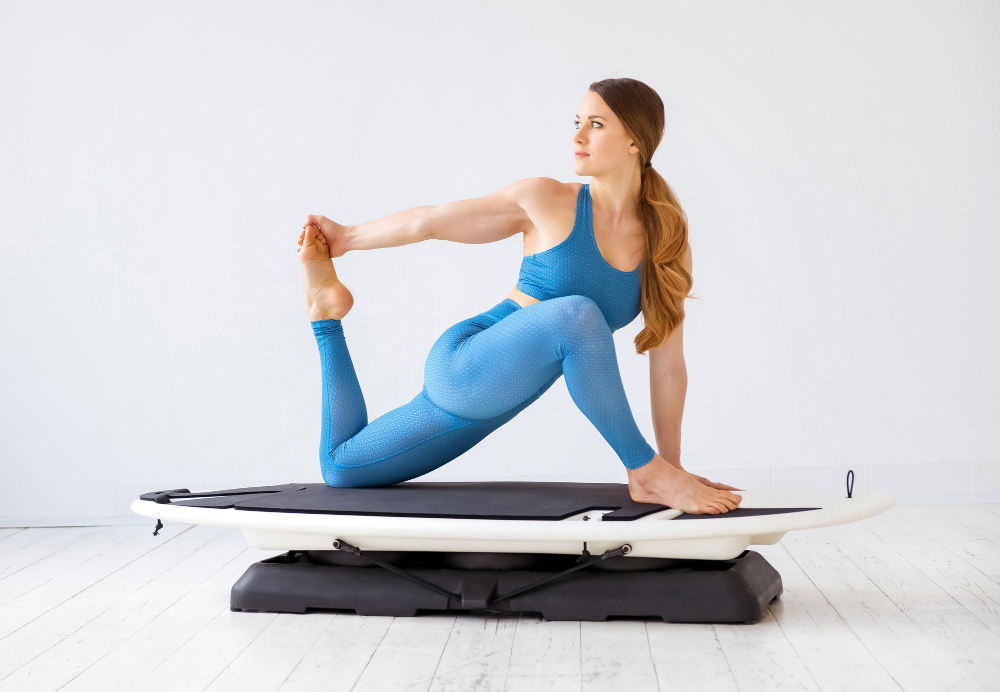Balance Board

A balance board is a versatile piece of fitness equipment designed to improve balance, coordination, strength, and core stability. It typically consists of a flat, rigid surface placed on an unstable base, such as a roller or a rounded bottom. Users stand on the board and perform various exercises that challenge their balance and engage multiple muscle groups, making it an excellent tool for rehabilitation, athletic training, and general fitness.
Benefits
Improved Balance and Stability: Using a balance board requires constant adjustments to maintain equilibrium, enhancing proprioception and overall balance.
Core Strength: Balancing on the board engages the core muscles, including the abdominals, obliques, and lower back, leading to improved core strength and stability.
Functional Strength: Balance board exercises simulate real-life movements and instability, helping to develop functional strength and coordination that translates to everyday activities and sports.
Rehabilitation: Balance boards are commonly used in physical therapy to aid recovery from injuries, particularly those affecting the ankles, knees, and lower body. They help improve joint stability, strength, and range of motion.
Athletic Performance: Athletes use balance boards to enhance their performance by improving agility, reaction time, and neuromuscular control, which are critical for sports that require quick changes in direction and stability.
Exercises
Basic Balance:
- Two-Legged Balance: Stand with both feet on the board and maintain balance without letting the edges touch the ground.
- Single-Leg Balance: Stand on one leg on the board, lifting the other foot off the surface to increase the challenge.
Strength Training:
- Squats: Perform squats while standing on the balance board to engage the lower body and core muscles.
- Lunges: Place one foot on the board and the other on the ground, then perform lunges to target the legs and glutes.
- Push-Ups: Place hands or feet on the balance board while performing push-ups to add instability and engage more muscle groups.
Core Stability:
- Planks: Hold a plank position with your hands or feet on the balance board to activate the core muscles.
- Mountain Climbers: Perform mountain climbers with your hands on the balance board to increase core engagement and balance challenge.
- Russian Twists: Sit on the board with feet off the ground, and twist your torso from side to side while holding a weight or medicine ball.
Coordination Drills:
- Tilt and Shift: Stand on the board and tilt it from side to side or front to back without letting the edges touch the ground.
- Figure Eights: Move the balance board in a figure-eight pattern using your feet or hands to improve coordination and control.
Types of Balance Boards
Rocker Boards: Have a flat, rigid surface with a curved base, allowing forward and backward tilting. Ideal for beginners and basic balance exercises.
Wobble Boards: Feature a rounded bottom that provides multi-directional instability, challenging users to maintain balance in all directions.
Roller Boards: Consist of a flat board placed on top of a cylindrical roller, providing a high level of instability and requiring advanced balance and coordination.
Spring Boards: Incorporate springs or flexible materials under the surface to create an unstable platform that mimics the movements of a trampoline or spring surface.
Safety Tips
Start with Support: If you’re new to using a balance board, start with support, such as holding onto a wall or a stable object, until you gain confidence and balance.
Use Proper Form: Maintain proper posture and alignment during exercises to avoid injury and maximize effectiveness. Keep your core engaged and knees slightly bent.
Gradual Progression: Begin with basic exercises and gradually progress to more advanced movements as your balance and strength improve.
Wear Appropriate Footwear: Use non-slip shoes or go barefoot to ensure a secure grip on the balance board.
Check Equipment: Regularly inspect your balance board for any signs of wear or damage to ensure safety during use.
Incorporating a balance board into your fitness routine can significantly enhance your balance, coordination, strength, and overall athletic performance. Whether for rehabilitation, sports training, or general fitness, balance boards offer a fun and effective way to challenge your body and improve functional movement skills.


